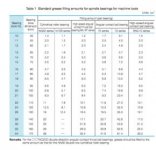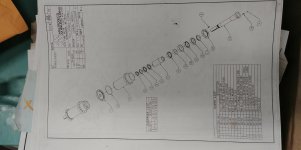Hi All,
Seeking advice on a bearing repair on my VMC spindle. I have sourced some NSK bearings 3 pieces 7011CTRSUMP3 and two 7009CTRSULP3 , cleaned everything thoroughly, nd greased with a lube recommended by bearing engineering for the bearing called lubriplate FGL-1 which could be the issue (approximately 2.5ml measured as recommended by NSK see chart).
The problem I am having is with the bearings overheating during run in cycle. I even took them off and installed a new set due to over greasing the previous set. The spindle taper runs true to .00005" so I don't believe that I have a misalignment or a binding issue. I am having trouble finding information on my spindle, like how to tighten the nut other than "tighten as tight as you can then back it off".
I am attaching some information on the spindle and drawings. The maker of the spindle is no longer in business even though the mill maker still is around. I am trying to find out if this is an issue with the nut tightness or the grease I used.



Thank you for any advice.
Seeking advice on a bearing repair on my VMC spindle. I have sourced some NSK bearings 3 pieces 7011CTRSUMP3 and two 7009CTRSULP3 , cleaned everything thoroughly, nd greased with a lube recommended by bearing engineering for the bearing called lubriplate FGL-1 which could be the issue (approximately 2.5ml measured as recommended by NSK see chart).
The problem I am having is with the bearings overheating during run in cycle. I even took them off and installed a new set due to over greasing the previous set. The spindle taper runs true to .00005" so I don't believe that I have a misalignment or a binding issue. I am having trouble finding information on my spindle, like how to tighten the nut other than "tighten as tight as you can then back it off".
I am attaching some information on the spindle and drawings. The maker of the spindle is no longer in business even though the mill maker still is around. I am trying to find out if this is an issue with the nut tightness or the grease I used.



Thank you for any advice.

